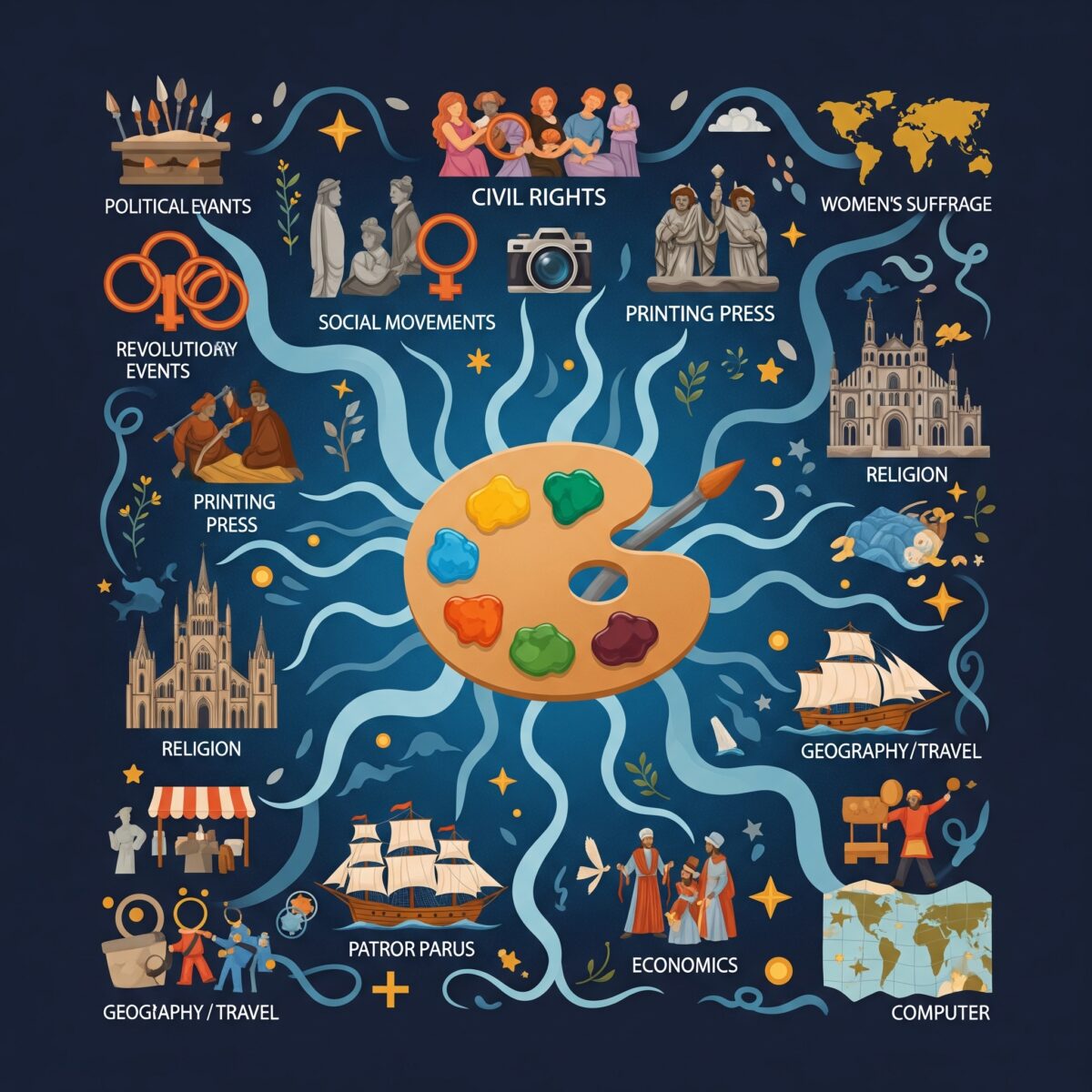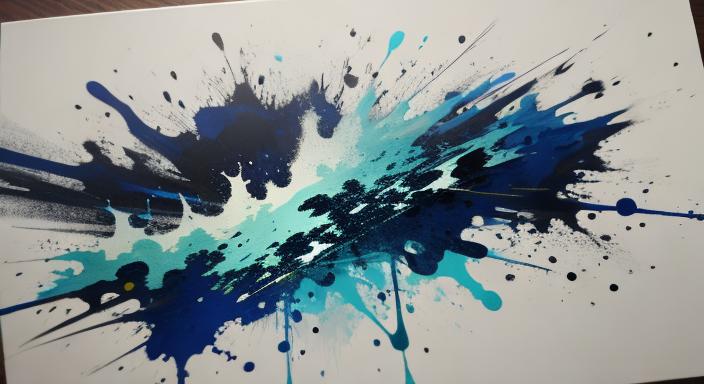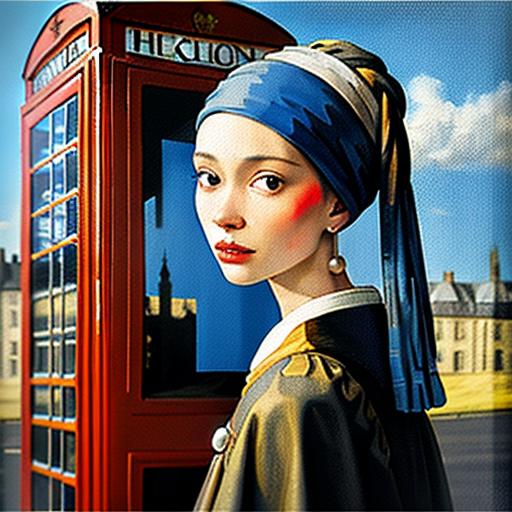Art evolution is like a giant family tree where each artistic movement learns from, builds upon, or rebels against what came before. From ancient cave paintings to today’s digital masterpieces, artists have always looked backward to move forward. Understanding how previous eras influence modern creativity helps us see art not as isolated works, but as part of an ongoing conversation that spans thousands of years.
Key Points Summary:
- Art movements build upon previous styles while introducing new innovations
- Renaissance artists revived classical techniques that still influence modern painters
- Technology and social changes drive artistic transformation across centuries
- Contemporary artists continue to reference and reinterpret historical art styles
- Understanding art evolution helps us appreciate both traditional and modern works
Art Evolution Timeline
How Previous Eras Shape Modern Artistic Development
The Ancient Foundations That Still Shape Art Today
Before we dive into art evolution, we need to understand where it all began. Ancient Greek and Roman artists established fundamental principles that artists still use today. They figured out how to create realistic human forms, developed composition rules, and explored themes that remain popular.
Think of these ancient artists as the inventors of art’s “instruction manual.” When Renaissance masters like Leonardo da Vinci studied classical sculptures, they weren’t just copying old styles – they were learning timeless techniques for creating believable human figures. Even modern artists who paint abstract works often understand these classical foundations first.
The concept of artistic development becomes clearer when we see how Byzantine and Medieval artists took classical techniques and transformed them to express religious themes. They didn’t abandon everything that came before; instead, they adapted ancient skills for new purposes. This pattern of adaptation and transformation continues throughout art history timeline.
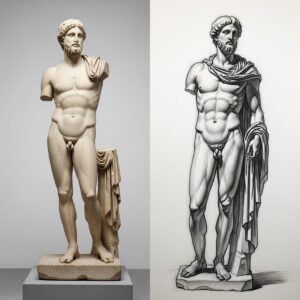
| Ancient Innovation | Modern Application |
|---|---|
| Perspective techniques | 3D digital art and virtual reality |
| Human proportion studies | Character design in animation |
| Color theory basics | Contemporary color psychology |
| Composition principles | Photography and graphic design |
The Renaissance Revolution: When Art Evolution Accelerated
The Renaissance period represents perhaps the most dramatic example of how previous eras influence artistic transformation. Italian Renaissance artists didn’t just randomly decide to paint differently – they deliberately studied ancient Roman and Greek art, then combined these classical techniques with new innovations.
Leonardo da Vinci exemplifies this artistic development. He studied ancient texts on human anatomy while also experimenting with new painting techniques like sfumato. Michelangelo carved marble using methods inspired by ancient Roman sculptors but created works that were unmistakably his own. This wasn’t copying – it was creative evolution.
The Renaissance also shows us how cultural art influence works. As trade expanded and ideas spread across Europe, artists began incorporating techniques from different regions. Northern Renaissance painters learned Italian perspective methods, while Italian artists adopted detailed realistic techniques from Flemish painters. This cross-pollination accelerated art movement progression in ways never seen before.
“The Renaissance teaches us that looking backward can actually propel art forward. Artists who understood classical techniques were better equipped to break new ground.”
Art historian Kenneth Clark
How Art Evolution Responds to Technological and Social Changes
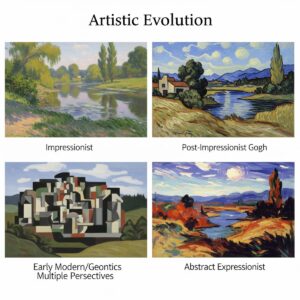
Art evolution speeds up dramatically when society undergoes major changes. The invention of photography in the 19th century perfectly illustrates this principle. Instead of making painting obsolete, photography forced painters to find new purposes for their medium.
Impressionist painters like Claude Monet responded to photography by focusing on things cameras couldn’t capture well at the time – fleeting light effects, emotional atmosphere, and quick impressions of scenes. They built upon traditional landscape painting techniques while developing entirely new approaches to color and brushwork.
This pattern continues through modern art transformation. When abstract expressionists like Jackson Pollock created their revolutionary drip paintings, they weren’t ignoring art history. Pollock studied Native American sand painting, Japanese calligraphy, and surrealist automatic drawing techniques. His innovative style emerged from combining these diverse influences in unprecedented ways.
Contemporary art emergence follows similar patterns. Today’s digital artists often reference classical compositions in their work, while street artists incorporate techniques from traditional mural painting. The tools may be new, but the creative process of building upon previous innovations remains constant.
The DNA of Artistic Movements: How Styles Pass Down
Understanding art evolution requires recognizing that artistic movements share DNA-like connections. Cubism didn’t appear out of nowhere – Pablo Picasso and Georges Braque developed it by studying African art, analyzing Cézanne’s geometric approach to form, and responding to their changing modern world.
Similarly, avant-garde movements often react against immediate predecessors while drawing inspiration from much earlier periods. The Dadaists rejected traditional art values, but they studied medieval art and non-Western traditions that offered alternatives to European academic painting.
This generational influence creates fascinating patterns in stylistic evolution. Romantic painters rebelled against Neoclassical formality but kept classical composition principles. Abstract Expressionists rejected European traditions but embraced Asian philosophical approaches to creativity. Each generation finds new ways to combine rebellion with respect for useful traditions.
For more insights into how different movements connect, explore our guide on painting styles and movements and learn about identifying different art movements.
Digital Age Art Evolution: Old Masters Meet New Media
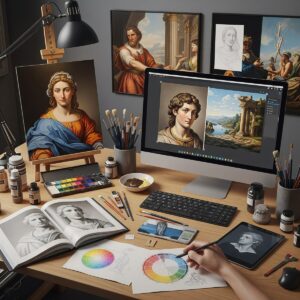
Today’s art evolution demonstrates how classical principles adapt to digital tools. Digital artists creating concept art for movies often study Renaissance masters to understand light, composition, and human anatomy. Video game designers reference Impressionist color techniques to create atmospheric environments.
Social media has accelerated artistic development by allowing instant global sharing of techniques and influences. A contemporary artist might combine Japanese woodblock printing styles, street art aesthetics, and digital manipulation tools in a single piece. This rapid mixing of influences represents art evolution at internet speed.
However, the fundamental process remains unchanged – artists study what came before, understand why certain approaches work, then apply this knowledge to their own creative challenges. Whether using traditional brushes or digital tablets, successful artists understand the foundations laid by previous generations.
Check out our comprehensive guide to digital art creation to see how traditional techniques translate to modern tools.
[Image placeholder: Split screen showing classical painting technique alongside digital art using the same principle]
Global Perspectives: How Cultural Exchange Drives Art Evolution
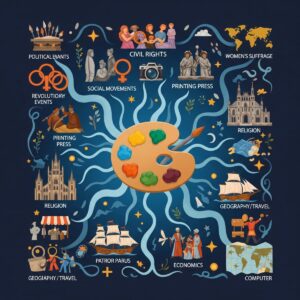
Modern art evolution increasingly reflects global influences rather than regional developments. Contemporary artists draw inspiration from traditions worldwide, creating hybrid styles that would have been impossible before global communication.
This cross-cultural artistic exchange enriches artistic development in unprecedented ways. African textile patterns influence European abstract painters, while Asian calligraphy techniques appear in American contemporary art. Japanese anime aesthetics blend with classical European portraiture techniques in digital illustration.
For deeper exploration of cultural influences, read our analysis of how location influenced art and discover the impact of indigenous painting in culture.
The Future of Art Evolution: Predicting Tomorrow’s Influences
Art evolution continues accelerating as new technologies emerge. Virtual reality, artificial intelligence, and biotechnology offer tools that previous generations couldn’t imagine. Yet if history teaches us anything, tomorrow’s revolutionary artists will likely combine these new possibilities with lessons learned from centuries of artistic development.
Understanding this continuous evolution helps us appreciate both traditional masterpieces and contemporary innovations. Each represents a moment in art’s ongoing conversation across time and cultures.
The story of art evolution reminds us that creativity thrives on connection rather than isolation. By studying how previous eras influence artistic development, we gain deeper appreciation for art’s remarkable ability to grow, adapt, and inspire across generations. Whether you’re viewing a Renaissance painting or a digital installation, you’re witnessing the latest chapter in humanity’s longest ongoing creative conversation.
Frequently Asked Questions
What caused art to evolve throughout history? Art evolved due to technological advancements, social and political changes, cultural exchanges between civilizations, religious influences, and economic factors that shaped how and why art was created.
How do art movements influence each other? Art movements influence each other through direct inspiration, reaction against previous styles, technical innovation sharing, philosophical exchanges, and cross-cultural exposure as artists study and respond to different traditions.
What are the major turning points in art evolution? Major turning points include the Renaissance discovery of perspective, the Industrial Revolution’s impact on art production, photography’s influence on painting styles, and the digital age’s transformation of artistic tools and distribution.
How does technology affect art evolution? Technology affects art evolution by providing new materials and tools, enabling new artistic mediums like digital art, changing how art is reproduced and distributed, and creating entirely new forms like virtual reality and interactive installations.
Why do artists rebel against previous styles? Artists rebel against previous styles due to generational desires for change, needs to comment on contemporary social issues, desires to break technical limitations, and expressions of changing cultural identities and values.
What role does society play in shaping art evolution? Society shapes art evolution through patronage systems that determine what gets funded, cultural values that influence subject matter, political climates that affect artistic freedom, and economic conditions that impact artistic production and distribution.

